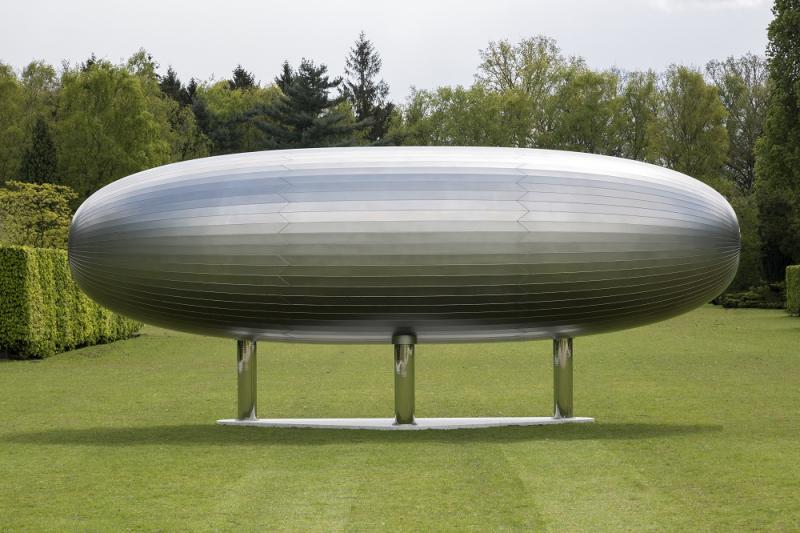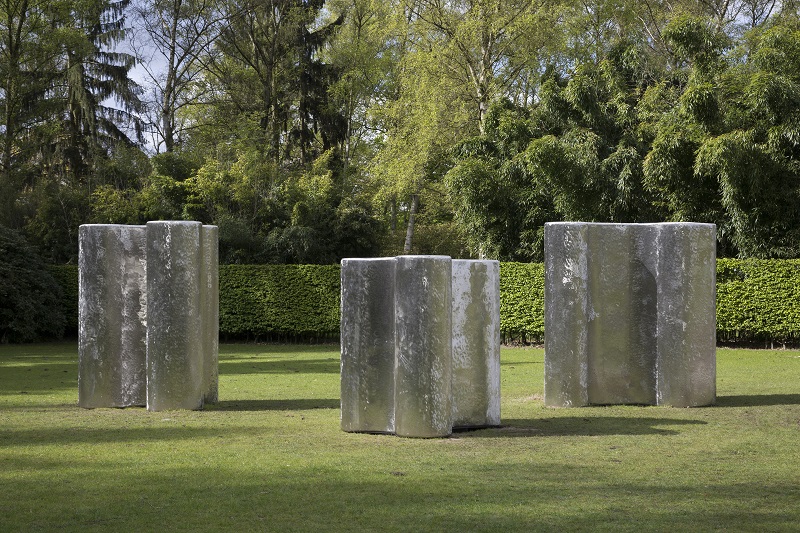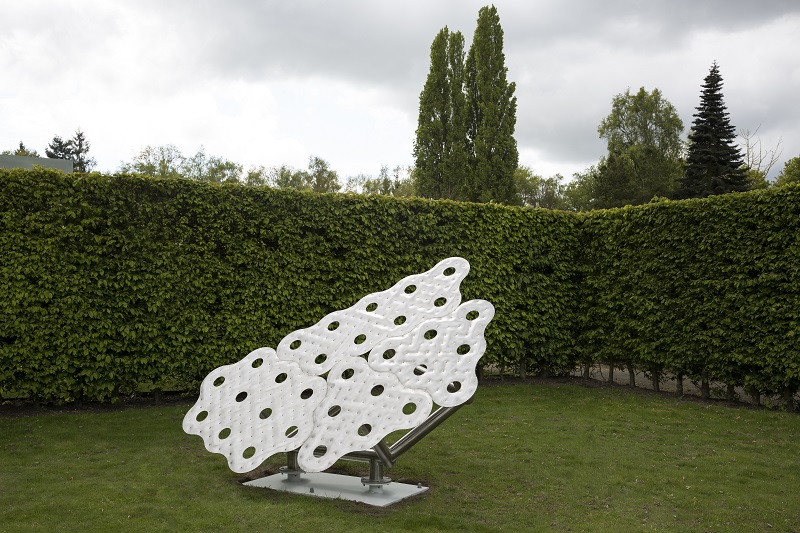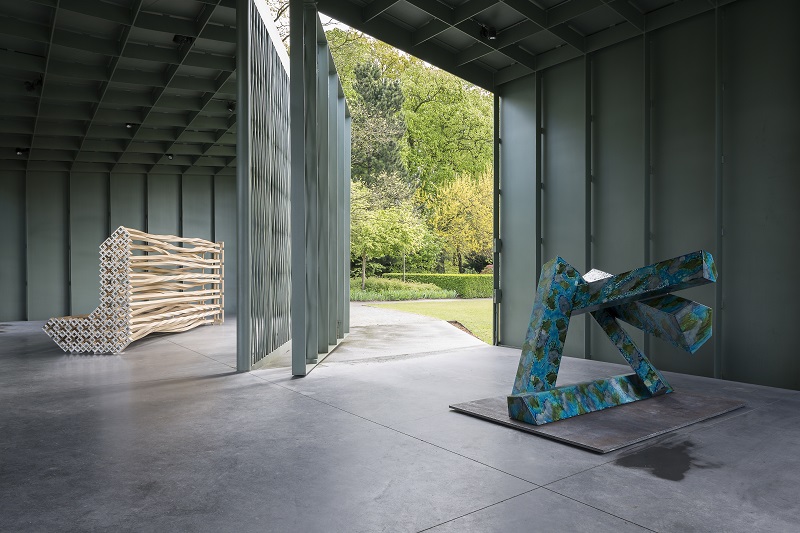theartsdesk in Antwerp: Richard Deacon says nothing | reviews, news & interviews
theartsdesk in Antwerp: Richard Deacon says nothing
theartsdesk in Antwerp: Richard Deacon says nothing
Art and life are irreconcilable in the British sculptor's solo show

Something like a parked zeppelin sits on three mirrored legs on a museum lawn in Belgium. It’s a cigar-shaped steel fabrication that, were it to float free of its three legs, could also pass for a UFO. But given the context - a sculpture park outside Antwerp - we can rest easy. Never Mind is a work of art by Richard Deacon.
Deacon’s works are all puzzles. This 765cm-long mirrored capsule offers few clues about its ultimate agenda. Was it sent here to frighten us, like an airborne invader? Is Never Mind (main picture) a tribute to the 1991 breakthrough LP by grunge band Nirvana? Or is it a formal investigation into materials and making? The latter is much more likely and, of course, much more challenging.
This monumental work is something of a talisman, both for this show, and for the museum which owns it: Middelheim. In 1993 they acquired a well-crafted version made out of curvaceous wooden slats. In the ensuing decades the piece rotted and following conversations with the artist and the arrangement of this landmark show, it was decided to replace the piece with a steel version. It’s a nice story, but it sheds little light on the meaning of the sculpture. Deacon is, one suspects, a sculptors' sculptor. For anyone who has ever worked with stainless steel, the huge work will take on a whole new level of interest. The drama is perhaps in the process rather than the finished artefact. There are times during this extensive show when the hard work becomes subject to the law of diminishing returns.
It’s a nice story, but it sheds little light on the meaning of the sculpture. Deacon is, one suspects, a sculptors' sculptor. For anyone who has ever worked with stainless steel, the huge work will take on a whole new level of interest. The drama is perhaps in the process rather than the finished artefact. There are times during this extensive show when the hard work becomes subject to the law of diminishing returns.
By way of illustration it’s worth considering Bikini, 1992, another monumental piece, which is squeezed into the Braem Pavilion. The two elements resemble a giant wristband and an upturned boat; the former is aluminium; the latter is wood. It is impressive but also lacking in appeal. It is monstrous, even, and indeed, the name could refer to the Bikini Atoll, where the US Government vaporised a string of Pacific Islands.
As a response to this, Deacon has created an oblique sculpture which also suggests a sexy two-piece for the beach. There is little apparent anger, disgust or despair from the playful artist; just a highly finished and beautifully crafted riddle. Only the absurdity of this leviathan provides any clue about the artist’s position. The diminishing returns must be the point he’s making.
That’s not to say that Deacon’s work never takes flight or floats free from the materiality which so interests him. His Custom series, 2016, comprises steel tube pillars, which the artist has buffed up with a metal brush to conceal the welded joins (pictured above). The resulting pattern shimmers in the light and resembles cursive script (it put me in mind of the Rosetta Stone. Though, of course, in this case it says nothing.) Another steely enigma is provided by the Infinity series, 2006 (pictured above). These are metallic screens comprised of elements like biology diagrams and angled like solar panels to greet the Belgian sky. There’s an optimism to these mutating cell forms, in as much as the life they represent will endure long after we have passed on. If art is for posterity, here is surely one for a future audience of amoebae.
Another steely enigma is provided by the Infinity series, 2006 (pictured above). These are metallic screens comprised of elements like biology diagrams and angled like solar panels to greet the Belgian sky. There’s an optimism to these mutating cell forms, in as much as the life they represent will endure long after we have passed on. If art is for posterity, here is surely one for a future audience of amoebae.
Repetition is central to Deacon’s practice and, for every piece in the show, there are numerous variations we cannot see. In this way they accrue resonance and perhaps demonstrate that for abstract art to strive for meaning is a task without end. Art is a strange currency in which each of the units in a series can become more valuable as the series grows. It’s another absurdity.
But amid the playfulness and apparent lack of intent, the show has an outbreak of good taste and politeness in the Het Huis pavilion. This deconstructed space features an interweaving metal grill which replaces sections of wall. As luck would have it, Deacon has made a series of sculptures that mirror these bars. But given his use of wood for his wave-like verticals, the I Remember series, 1999-2013 (pictured below), is a technical triumph. Or perhaps the technique is simply more tangible in the cases where Deacon works in wood, whose limitations are better known.
It is not that Deacon ever hides the challenging process behind his work. Indeed, visitors will get a full glimpse behind the scenes of Never Mind in a looped film and a section of the catalogue given over to production notes. The difficulty of the rest of the pieces here is that we don’t always grasp just what the artist and his assistants have managed to achieve. The work is like the rabbit pulled from a hat, long after the hat has been removed. In this respect his most emblematic works are the vector patterns which appear in two dimensions on the Braem Pavilion wall and, in an additional dimension as floor-standing pieces, using glazed ceramic and powder-coated steel. They refer to one another in a circular relationship into which it can be hard to intervene.
In this respect his most emblematic works are the vector patterns which appear in two dimensions on the Braem Pavilion wall and, in an additional dimension as floor-standing pieces, using glazed ceramic and powder-coated steel. They refer to one another in a circular relationship into which it can be hard to intervene.
The serial format of Deacon’s work may be an abstract visual language. Indeed, his wall-mounted vectors are named after letters of the alphabet. But this only highlights the difficulty of using art to communicate.
Deacon is by all accounts a very considered artist. He won the Turner Prize back in 1987, and here at Middelheim he enjoys a legendary reputation. He must be aware that his work is so oblique. Yet he remains an abstract sculptor, committed enough to his sculptural pieces that he can spend considerable energy refabricating his earlier work.
It’s as if, when it comes to art and real life, never the twain shall meet; or it is as if he concurs with the oft-quoted words of composer John Cage, “I’ve got nothing to say and I’m saying it”. But at our present historical moment, one might question whether saying nothing is a luxury we can afford.
- Richard Deacon: Some Time at the Middelheim Museum, Antwerp until 24 September 2017
- Read more visual arts reviews on theartsdesk
rating
Explore topics
Share this article
more Visual arts
 Eye to Eye: Homage to Ernst Scheidegger, MASI Lugano review - era-defining artist portraits
One of Switzerland's greatest photographers celebrated with a major retrospective
Eye to Eye: Homage to Ernst Scheidegger, MASI Lugano review - era-defining artist portraits
One of Switzerland's greatest photographers celebrated with a major retrospective
 Stephen review - a breathtakingly good first feature by a multi-media artist
Melanie Manchot's debut is strikingly intelligent and compelling
Stephen review - a breathtakingly good first feature by a multi-media artist
Melanie Manchot's debut is strikingly intelligent and compelling
 Fantastic Machine review - photography's story from one camera to 45 billion
Love it or hate it, the photographic image has ensnared us all
Fantastic Machine review - photography's story from one camera to 45 billion
Love it or hate it, the photographic image has ensnared us all
 Yinka Shonibare: Suspended States, Serpentine Gallery review - pure delight
Weighty subject matter treated with the lightest of touch
Yinka Shonibare: Suspended States, Serpentine Gallery review - pure delight
Weighty subject matter treated with the lightest of touch
 Jane Harris: Ellipse, Frac Nouvelle-Aquitaine MÉCA, Bordeaux review - ovals to the fore
Persistence and conviction in the works of the late English painter
Jane Harris: Ellipse, Frac Nouvelle-Aquitaine MÉCA, Bordeaux review - ovals to the fore
Persistence and conviction in the works of the late English painter
 Sargent and Fashion, Tate Britain review - portraiture as a performance
London’s elite posing dressed up to the nines
Sargent and Fashion, Tate Britain review - portraiture as a performance
London’s elite posing dressed up to the nines
 Zineb Sedira: Dreams Have No Titles, Whitechapel Gallery review - a disorientating mix of fact and fiction
An exhibition that begs the question 'What and where is home?'
Zineb Sedira: Dreams Have No Titles, Whitechapel Gallery review - a disorientating mix of fact and fiction
An exhibition that begs the question 'What and where is home?'
 Yoko Ono: Music of the Mind, Tate Modern review - a fitting celebration of the early years
Acknowledgement as a major avant garde artist comes at 90
Yoko Ono: Music of the Mind, Tate Modern review - a fitting celebration of the early years
Acknowledgement as a major avant garde artist comes at 90
 Unravel: The Power and Politics of Textiles in Art, Barbican review - the fabric of dissent
An ambitious exploration of a neglected medium
Unravel: The Power and Politics of Textiles in Art, Barbican review - the fabric of dissent
An ambitious exploration of a neglected medium
 When Forms Come Alive, Hayward Gallery review - how to reduce good art to family fun
Seriously good sculptures presented as little more than playthings or jokes
When Forms Come Alive, Hayward Gallery review - how to reduce good art to family fun
Seriously good sculptures presented as little more than playthings or jokes
 Entangled Pasts 1768-now, Royal Academy review - an institution exploring its racist past
After a long, slow journey from invisibility to agency, black people finally get a look in
Entangled Pasts 1768-now, Royal Academy review - an institution exploring its racist past
After a long, slow journey from invisibility to agency, black people finally get a look in
 Barbara Kruger, Serpentine Gallery review - clever, funny and chilling installations
Exploring the lies, deceptions and hyperbole used to cajole, bully and manipulate us
Barbara Kruger, Serpentine Gallery review - clever, funny and chilling installations
Exploring the lies, deceptions and hyperbole used to cajole, bully and manipulate us

Add comment